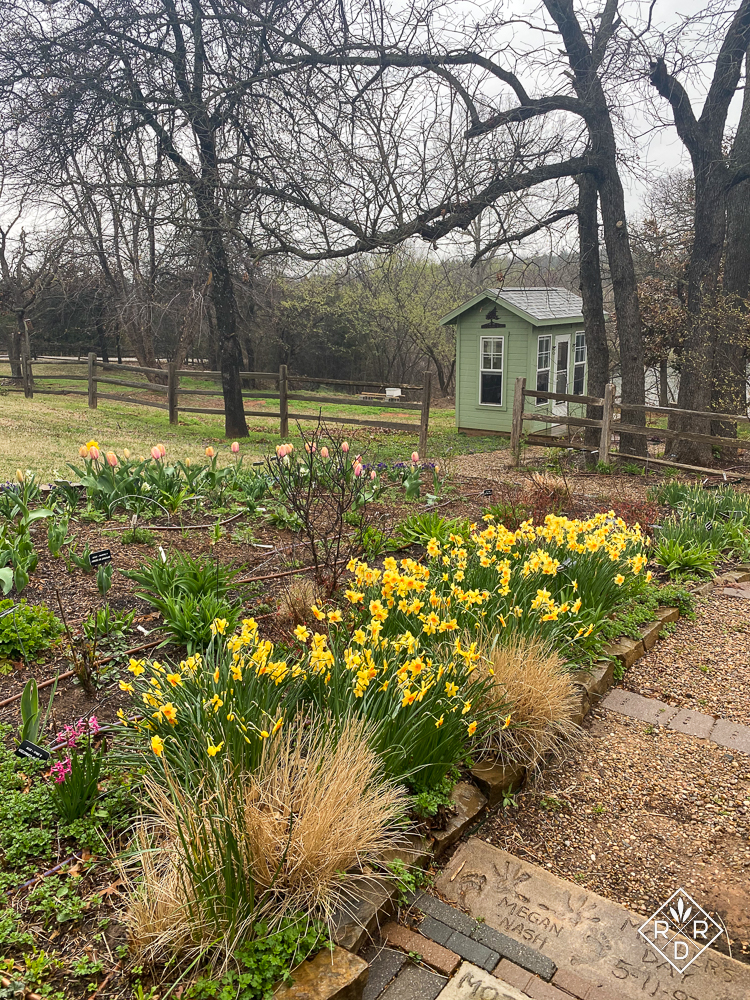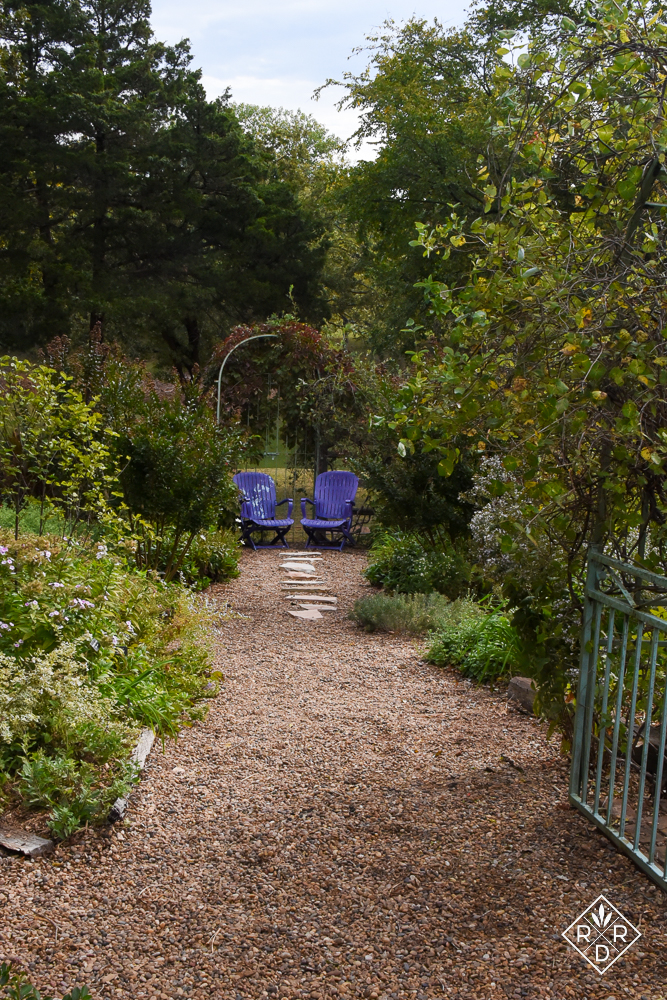Last Saturday, while planting pansies and violas for fall and cleaning up my front borders, I began to ponder ten ways to enjoy your garden more.

I always get my best ideas in the garden. Don’t you?

First, the bullet points.
- Plant things where you can see them coming and going.
- Consider building raised beds.
- Automate your watering.
- Grow some plants in containers with irrigation already installed.
- Grow what you love
- Size the garden for the resources you have.
- Respect Mother Nature.
- Buy good tools.
- Grow plants for others.
- Grow more of the same thing and fewer “collections of one.”
Plant things where you can see them coming and going.

To enjoy your garden more, grow your favorite plants, especially those with high color where you will see them coming and going. In other words, if you park your car on your driveway, be sure you have some real beauty for your walk into the house. Also, plant beautiful things or containers on either side of your front door.

I write and record the podcast in my kitchen, which is one of my favorite rooms in my house. For years, I didn’t have anything planted outside this kitchen door, but when I was on tour one year for the Oklahoma Horticultural Society, Bill and I expanded a sidewalk border. Here, I have my favorite roses, and it’s where I plant my tulip bulbs so I can see them.




You should have scent and beauty right where you walk each and every day. I planted English roses, ‘Munstead’ and ‘Desdemona’ in this border, where I can smell them as soon as I step outside to take a writing break. I also planted asters and Gregg’s mistflower to attract butterflies. It’s okay to partner refined roses with prairie plants. This is Oklahoma gardening at its finest, in my opinion.
Plus, you will enjoy your garden so much more.

Consider building raised beds.

It’s an investment, but gardening is one big, lifelong investment in an ephemeral hobby.
Think about that for a moment. Your garden only lasts as long as you do, but it will bring you joy throughout your life even when the grasshoppers try your patience.

In my garden, raised beds changed my life.
If you build raised beds, you can choose the soil you want. You don’t have to deal with clay, and Oklahoma has a lot of clay soil.
As I have aged–I started this garden 34 years ago–I find that raised beds keep me from constantly being on the ground on my knees.
I built my raised beds to about four feet tall because I like to lean or sit on the edge.

In the potager (kitchen garden), we actually use the walls as seating.
Sitting out there, drinking iced tea while resting, and watching the fountain burble is lovely. I had so many bumblebees this year on the Salvia ‘Indigo Spires Blue’ that it felt magical.
If you build raised beds, you will enjoy your garden more.
Automate your watering.
I realized a long time ago I wouldn’t go out and water my garden every day when it’s summertime. It’s just too hot, and I don’t want to. You won’t either. I relied on timers and soaker hoses for years, but after 28 years, I got a real irrigation system. Because I had 100 roses at the time, we put in drip Netafim hosing almost everywhere. I’m now really glad I did.



I still use soaker hoses and timers in my cut flower gardens, but I’m getting ready to replace the soaker hoses, which have rotted, with Netrafim tubing. I’ll still keep the timers.

I also water all my containers containing tomatoes and peppers with drip irrigation. This is the black tubing you’re probably more familiar with.

I bring in the timers before we have a freeze. Frozen timers like frozen hand sprayer nozzles break.
If you automate your watering in some fashion, you will enjoy your garden more.
Grow some plants in containers with irrigation already installed.
I’m a big fan of growing not only ornamental plants in containers but vegetables as well. Tomatoes, potatoes, peppers, eggplant, squash, cucumbers, and melons all produce very well in large fabric containers. I have mine running down the middle of our original driveway, which was unused space before. We installed field fencing down the center so I could tie cucumbers, tomatoes, melons, and other plants to keep them up off the asphalt or potting soil.

I will change one thing next season. I will plant the large, indeterminate tomatoes on the west side of the field fencing so that the shorter peppers get more sun.
Do I replace the potting soil each season? Yes, most years, I do. Yes, I know it’s expensive. However, the safest bet is to replace it. It’s like rotating your crops in a normal planting arrangement, reducing disease and insects. Use the spent potting soil somewhere else in your garden.

Also, ensure you’ve installed black drip irrigation before planting your tomatoes and other veggies or ornamental plants. You don’t want to be out there in 103°F heat watering ten or twelve pots. I promise.
Grow what you love
This one is simple. Grow what you love to enjoy your garden more. However, I would also add that you should start by deciding what you really want from your garden. In other words, don’t grow roses if you don’t want to deal with Japanese beetles because if you plant roses, the beetles will come.





Gardening success is possible.
Start with easy beautiful things like long-flowering perennials, annuals, and tropicals that make the best of a hot and dry summer. What are these? Helenium spp., autumnal sneezeweed, various salvias, Phlox paniculata, ‘Bluebird’ smooth aster, or ‘Hella Lacy’ aster, and good garden mums are all great plants for a long flowering, easy-to-grow, sunny garden. Add in some annuals like the ‘Oklahoma’ series zinnias and Tithonia ‘Torch’ for more color, and be sure to deadhead them to keep them blooming.




Intersperse all this flowering goodness with tropical plants that have great leaf color. You can’t go wrong with coleus, Hibiscus ‘Mahogany Splendor,’ or other tropical plants. They add so much color to the garden, and because they don’t have to put their energy into making flowers, they handle our heat so well.
Size the garden for the resources you have.
Now, you might think that means material resources, and it does, but it also means physical resources. When you were 20, you may not have had much money, but you had time and energy. Becoming a parent limits time, energy, and money too.





You will find that you usually make better money as you age, but you have less time and strength. Size your garden for where you are in your life at the current time. Check out my Instagram reel, where I talk about the changes to my own garden over the years.
Respect Mother Nature.
What is your climate like? Quit trying to grow outside your zone. Every gardener I know tries to grow plants outside their hardiness zones. We also need to factor in how much water we have available and what we’re willing to spend.

Respecting Mother Nature also means growing some easy things like zinnias. You can try dahlias too, but easy things make gardening season more fun. You can also grow summer flowers easily from seed. It’s also frugal, and we all need that these days.

Buy good tools.
You don’t need that many, so buy quality tools.
- You need a good trowel.
- A good pair of pruners that don’t crush stems. I like Felco pruners and Corona floral snips.
- A rake. I like shrub rakes because they are narrow, including this Fiskars hand rake.
- A shovel or two. My current favorite is this spear head shovel.
- A good hand weeder. Everyone has their favorite. This Japanese one is mine.
- A good rubber hose. I like the Craftsman ones that won’t kink. In my large garden, I have four different hose stands with 100 feet of hose on each.
- A multi-pattern, hose-end nozzle sprayer to water your new plants. You’ll need to bring it indoors before winter, or it will freeze and bust.
- Your phone for so many reasons. Take pictures in the garden. Call if you need help. Identify plants. Phone a friend.
- A garden cart or wheelbarrow for hauling around bags of mulch and dumping weeds. I actually use my garden tractors and carts all the time now. I have a small cart for the back garden because I can’t get the larger carts back there. I think I’ll invest in a gorilla cart next time.
Grow plants for others.
We reach beyond ourselves by growing plants for others like our neighbors, children, grandchildren, and pollinators. Our children went to Catholic schools which stressed the acronym of JOY. The kids were taught to think first of Jesus, others, and yourself. The more we reach outside of just growing our garden for ourselves, the more joy we will find in it.

Grow more of the same thing and fewer “collections of one.”
If you want your garden to look cohesive, plant more of the same thing. The eye likes repetition as it travels around the garden or even in home decor. In other words, quit creating “collections of one.”
You don’t need to grow every new plant that comes on the market. You may want to, but give new plants a year or so before you invest especially if it’s a new shrub or tree.

Ok, that was one long post. Check out our latest podcast episode below.
One more thing, Monarchs and other butterflies like painted ladies are moving throughout the state. Like your garden, butterflies and fall are ephemeral. Enjoy them while you can.

Discover more from Red Dirt Ramblings®
Subscribe to get the latest posts sent to your email.


Oh, Dee. This whole beautiful post was so good to read. It could be expanded deliciously into a new book, hint hint xoxo
I especially appreciate your advice about growing for others (JOY), growing what we love, and growing beyond collections of one. It takes a bit of discipline, but worthwhile I think. And thanks for the nudges lately to plan for shifting resources and physical energy, etc. smart!
Thank you Marie! Maybe I should write another book. I don’t know. They are so much work, and I so enjoy garden coaching and such. ~~Dee
Lots of good information here. Thanks Dee for sharing your knowledge. I’m new to Edmond and I am always looking for tips from someone local on what to grow and when to plant.
Hi Decah, I’m glad to help. Have a beautiful fall while it lasts. ~~Dee